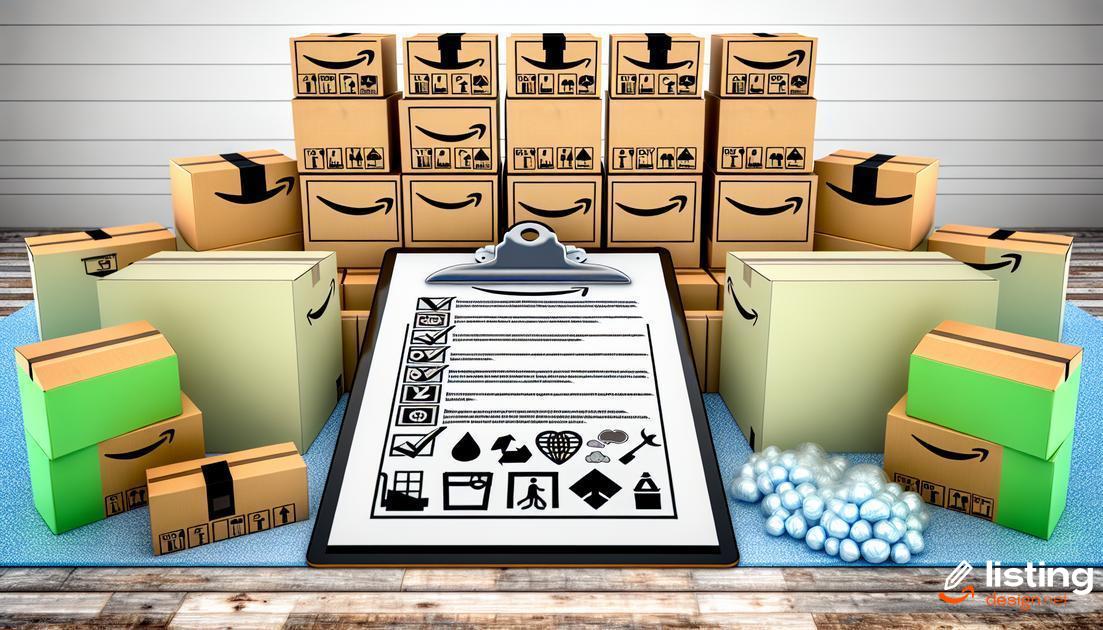Navigating the intricate world of Amazon Packaging Rules and Guidelines is crucial for any seller looking to succeed on the platform. Proper compliance not only helps in ensuring product safety during transit but also enhances customer satisfaction. In this blog post, we will break down the essential tips and strategies to meet Amazon’s packaging requirements effectively, covering topics from eco-friendly solutions to handling fragile items. Dive in to learn the best practices and avoid common mistakes.
Table of Contents
Understanding Amazon’s Packaging Requirements
For sellers on Amazon, meeting packaging requirements is non-negotiable. Packaging that adheres to Amazon’s standards not only ensures customer satisfaction but also compliance with the marketplace’s rules.
Dimensions and Weight: Amazon mandates specific dimensions and weight limitations to streamline storage and transportation. Be aware of these limits to avoid penalties.
Durability: The packaging must be robust enough to protect the product during transit. Use adequate cushioning materials like bubble wrap or foam inserts.
Taping and Sealing: To prevent tampering, ensure all packages are securely sealed. High-quality packing tape should be used to reinforce seams and edges.
Barcode Placement: Proper barcode placement is crucial for Amazon’s warehouse system. Ensure barcodes are clearly visible and not obscured by tape or other labels.
Poly Bags and Suffocation Warnings: If using poly bags, make sure they are transparent and include a suffocation warning. Bags must also be thicker than 1.5 mils.
Expiration Dates: For perishable items, ensure the expiration date is printed on both the item and the outer packaging, and that the dates are easily readable.
Common Mistakes to Avoid

Complying with Amazon’s packaging guidelines can be tricky if you’re not aware of the common pitfalls. Avoid using inadequate cushioning materials; improper padding can lead to damaged products. Ensure all packages are securely sealed to withstand transit handling.
Overpacking is another mistake that results in increased shipping costs and environmental waste. Instead, focus on right-sizing your packaging. Likewise, undersized packaging can lead to product damage, affecting customer satisfaction.
Inadequate or incorrect labeling can also cause issues. Make sure all package labels are clearly visible and include the necessary details like barcodes and shipping addresses. Double-check regulatory requirements to avoid shipping delays.
Finally, avoid using prohibited materials such as hazardous substances or packaging that isn’t environmentally friendly. Amazon has strict guidelines to ensure all packaging materials meet safety and sustainability standards.
How to Ensure Product Safety During Transit
Eco-Friendly Packaging Solutions

Adopting eco-friendly packaging solutions is a crucial step towards sustainability and complying with Amazon’s packaging guidelines. Utilizing recyclable materials, reducing packaging waste, and opting for biodegradable options can make a significant difference.
Choose Recyclable Materials: Opt for materials that can be recycled, such as cardboard, paper, and certain types of plastics. This reduces the environmental impact and aligns with Amazon’s commitment to sustainability.
Minimize Packaging Waste: Ensure that the packaging is appropriately sized for the product. This not only reduces waste but also cuts down on shipping costs. Avoid excessive use of fillers and opt for eco-friendly alternatives like recycled paper or air pillows.
Biodegradable Options: Consider using biodegradable packaging materials. These materials break down naturally over time, reducing environmental harm. Examples include cornstarch-based packing peanuts and biodegradable bubble wrap.
Incorporate Reusable Packaging: Reusable packaging solutions can add value for customers and encourage eco-friendly practices. Examples include cloth bags, sturdy boxes, or containers that can be repurposed.
Eco-Friendly Labels and Inks: Use labels and inks that are environmentally friendly. Soy-based inks, for instance, have a lower environmental impact compared to traditional petroleum-based inks. Ensure labels are recyclable along with the packaging.
By choosing eco-friendly packaging solutions, sellers can contribute to a more sustainable future and adhere to Amazon’s packaging rules, which increasingly emphasize environmental responsibility.
Importance of Labeling Requirements
Labeling requirements are critically important in ensuring that packages comply with Amazon’s standards. Correct labeling helps prevent delays and guarantees that products reach customers in pristine condition. Each label must include all relevant information, like product identifiers (like ASINs), barcodes, shipping details, and any specific handling instructions.
Labels must be clear and easy to read to avoid any scanning issues during the fulfillment process. It’s essential to use durable labels that can withstand different handling and weather conditions. Make sure that labels are placed on flat surfaces and are fully visible to ensure smooth operations. Faded, damaged, or incorrectly placed labels can cause significant operational hiccups and customer dissatisfaction.
Ensuring that your labels provide accurate information will not only help in compliance but also improve your product’s reputation, as customers rely on these labels for correct product information. If your products require specific handling, always add appropriate handling labels to inform Amazon’s fulfillment centers and the end consumer.
Handling Fragile Items

When packaging fragile items, it is crucial to use materials that provide adequate cushioning and protection. Bubble wrap, packing peanuts, and foam inserts are essential to absorb shock and prevent breakage during transit.
Make sure to wrap each item individually and place it in a sturdy box. The box should be slightly larger than the item, allowing room for cushioning materials. This prevents items from shifting and protects them from external pressure.
Double-Boxing Technique
For extra protection, especially for highly fragile items like glassware or electronics, consider using the double-boxing technique. Place the wrapped item in a smaller box, then place this box inside a larger one filled with additional cushioning materials. This method provides an extra layer of protection against impacts.
Labeling is KeyEnsure that you label the package as fragile. This alerts handlers to take extra care during the shipping process. Use clearly visible and standardized labels for maximum effectiveness.
Testing and Validation
Before finalizing your packaging, conduct drop tests and shake tests to validate its effectiveness. This helps in identifying weak points and making necessary adjustments to ensure maximum protection.
Follow these guidelines to handle fragile items effectively and ensure they reach your customers in perfect condition.
Shipping Hazardous Materials
Cost-Effective Packaging Strategies

Implementing cost-effective packaging strategies is crucial for maintaining profitability on the Amazon platform while ensuring product safety and compliance. One effective approach is to utilize lightweight, durable materials that meet Amazon’s packaging guidelines. Switching to alternative materials such as corrugated cardboard or poly mailers can significantly reduce shipping costs.
Choosing the right size of packaging is another way to cut costs. Over-sized boxes lead to higher dimensional weight charges, so optimizing box size to fit the product snugly is essential. Automated packaging solutions can also streamline this process and reduce wastage.
Another strategy is to purchase packaging materials in bulk. This not only lowers the per-unit cost but also ensures a steady supply, minimizing the risk of delays and consequently, poor customer reviews. Partner with suppliers who offer volume discounts and maintain a consistent quality of materials.
Reuse and recycling provide both economic and environmental benefits. Encourage consumers to return packaging materials for reuse or use recycled materials for new packaging. This practice can lower material costs and appeal to the eco-conscious consumer, enhancing brand loyalty and reputation.
Regularly reviewing and analyzing the performance of your packaging strategies is key. Utilize Amazon’s feedback system to make data-driven decisions about which materials and processes are the most cost-effective and efficient. This continuous improvement cycle helps maintain cost-effectiveness while adapting to any changes in Amazon’s guidelines or market conditions.
Amazon’s Packaging Feedback System
Amazon’s Packaging Feedback System is a valuable tool for sellers to gauge the effectiveness of their packaging. Utilizing this system helps in understanding how well packaging meets Amazon’s standards and customer expectations. When feedback is provided, it allows sellers to identify areas for improvement, ensuring that products are protected during transit while minimizing waste.
The system collects feedback from customers regarding the condition of the packaging upon arrival. This includes noting any damages or issues encountered. By addressing this feedback, sellers can reduce the incidence of product damage and enhance customer satisfaction. Regularly reviewing this feedback can lead to continuous improvements in packaging strategies.
Amazon’s Packaging Feedback System also contributes to better understanding eco-friendly packaging practices that resonate well with customers. Using recyclable or biodegradable materials can result in positive feedback and foster a greener brand image.
For consistent positive responses, sellers should integrate learnings from the feedback into their packaging decisions. This proactive approach not only aligns with Amazon’s packaging guidelines but also promotes overall efficiency and sustainability in operations.
Sustainable Packaging Practices

Adopting sustainable packaging practices can significantly reduce your environmental footprint while ensuring that products reach customers in excellent condition. These practices often involve the use of recyclable and biodegradable materials to minimize waste. For example, replacing traditional bubble wrap with inflatable air pillows made from recyclable plastic can be an effective solution. Additionally, businesses should consider utilizing boxes made from recycled cardboard, which are both sturdy and eco-friendly.
Another critical aspect of sustainability in packaging is reducing the packaging size to fit the product without leaving excess space. This approach not only cuts down material usage but also lowers shipping costs due to reduced volume and weight. Moreover, using minimal ink for printing on packages and choosing soy-based or water-based inks can further enhance the eco-friendliness of your packaging.
Implementing a take-back program for packaging materials, where customers can return the packaging for reuse or recycling, demonstrates a commitment to sustainability. Furthermore, educating customers on proper disposal methods can encourage them to recycle or reuse packaging, thereby extending the lifecycle of the materials used.
Incorporating eco-friendly packaging solutions can also enhance your brand reputation as consumers are increasingly favoring companies that prioritize environmental sustainability. By being proactive about sustainable packaging, businesses can meet Amazon’s compliance standards and contribute to a healthier planet.
Consumer-Friendly Packaging
Attention to Detail
Consumer-friendly packaging involves paying close attention to the details that matter most to end-users. This includes easy-to-open designs, clear instructions, and minimal but effective protective materials.
User Experience Design
Packing your products in a way that enhances user experience can significantly impact customer satisfaction. Consider using packaging that is simple to open and reseal, reducing frustration during unboxing.
Innovative Solutions
Adopting innovative solutions such as frustration-free packaging can differentiate your brand. Simple and effective packaging methods can leave a lasting impression and increase brand loyalty.
Safety and Integrity
Product safety and integrity should never be compromised. Ensure that consumer-friendly packaging still adequately protects the product during transit. Balance between user-friendliness and robustness is key.
Reusable and Recyclable
Consider packaging designs that promote reusability or recyclability. Eco-friendly materials not only appeal to environmentally conscious consumers but can also reduce waste and lower costs in the long run.
Clear Labeling
Ensure all packaging has clear and concise labels. This can include handling instructions, product information, and recycling guidelines. Clear labeling helps avoid confusion and promotes proper handling and disposal by the consumer.
Case Studies of Best Practices

Exploring real-world examples helps in understanding how leading brands adhere to Amazon’s packaging rules.
Brand A: Streamlining Packaging Efficiency
Brand A implemented a robust packaging protocol that minimized waste, enhanced product protection, and met all of Amazon’s requirements. They invested in automated packaging solutions, which reduced labor costs and improved packaging consistency.
Key Takeaways:
- Utilize automated packaging systems for efficiency.
- Focus on reducing packaging waste while ensuring product safety.
- Regularly review and update packaging procedures to remain compliant.
Brand B: Prioritizing Eco-Friendly Approaches
Brand B switched to recyclable and biodegradable materials without compromising packaging integrity. They received positive feedback from both Amazon and their consumers for their commitment to sustainability.
Key Takeaways:
- Adopt sustainable packaging materials such as recycled cardboard and biodegradable plastics.
- Educate consumers on the benefits of eco-friendly packaging.
- Monitor feedback to identify areas for further improvement.
Brand C: Ensuring Product Safety and Compliance
Brand C focused on enhancing product safety measures during transit. They utilized shock-absorbing materials and conducted rigorous testing to ensure that their packaging withstood various shipping conditions.
Key Takeaways:
- Incorporate sturdy, shock-absorbing materials in packaging.
- Conduct regular testing to ensure packaging meets high safety standards.
- Stay updated with Amazon’s packaging guidelines and adjust practices accordingly.


